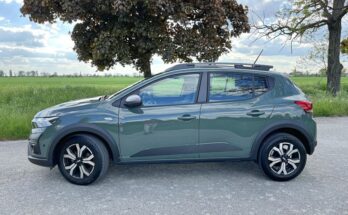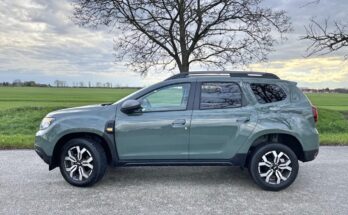Dacia is a brand for people who do not suffer from unnecessary things. It offers austere utility and doesn't try to impress. Not everyone is familiar with this approach, but its quality under roughly shaped sheets cannot be questioned. This is also confirmed by the second generation Dacia Duster with a new LPG version.
Modern Dacia before approx. fifteen years ago they discovered it like a bolt from the blue and since then they have been patiently conquering an ever larger part of the market. Cars invented for Russia, India or Algeria are modest in equipment and design, but mechanically robust and almost indestructible. Initially only a trial launch in Europe, with the last economic crisis, it turned out to be a very good move, and the sales of this brand gradually climbed to over half a million vehicles a year.

Thanks to low purchase prices and cheap service, Dacia was liked by many traditionally thinking people used to turning over every crown twice and not throwing away things that can be repaired. The arrival of the Duster SUV in 2011 gave this approach a necessary dose of confidence. Even three-year-old Duster drivers keep their prices so high that it is more worthwhile to pay extra for a new car.

The correctness of the original idea confirms that the second generation, presented in the spring of 2018, is in fact rather a large-scale modernization. Beneath the finer design, nicer interior, expanded equipment and smoother ride, primitive mechanics still hide in the best sense of the word, meeting current green requirements in the simplest ways. This is also confirmed by the new version with the 1.0 TCe engine, in the basic version for gasoline, seconded by the factory modification for LPG.

On the one hand, the liter three-cylinder follows the modern trends of small volume and turbocharging, on the other, it retains the simple MPI injection known since the 90s. This system is cheaper to manufacture and, in addition, the engine does not suffer from the tendency to form carbon deposits. The indirect injection engine doesn't mind so much when you bother it with frequent short journeys where it doesn't even have time to warm up. The disadvantage is less efficiency under full throttle, because the gasoline evaporates earlier during the compression period and could catch fire at the wrong moment. To avoid this, the vigilant electronics do not even let the engine into too high a pressure, so the power reaches only 74 kW, while some competitors with direct injection easily get over 100 kW values.
In the Duster, this engine confirms the muted dynamics immediately after the first few kilometers. Starts are lethargic to say the least, and engine response below 2000 rpm is almost non-existent. It is only above this value that the small three-cylinder wakes up to some activity to show a very solid thrust in the middle revs, which can then be sufficient until you pick up the pace and the turbo spins the blades at full speed. For driving between 50 and 100 km/h, a four and a five are basically enough, which at 100 turns a quite comfortable 2600 rpm. The engine is pleasantly quiet and emits only minimal vibrations into the cabin.

The lower efficiency is reflected in consumption, which in a mix of district roads and city traffic easily reaches over 6.5 l / 100 km. More sophisticated direct injection engines would draw at least 0.5 l less under the same conditions. This ailment is more noticeable on the highway, where the sixth gear is sorely lacking, and in fifth gear the Duster spins the engine to 3400 rpm and the consumption rises to 8 l/100 km.
But we don't care about all that, because our Duster runs on LPG. Folk wisdom says that we should feel a reduction in performance, but even if we switch from gasoline to gas, but here it is rather the opposite. In the past, naturally aspirated engines suffered from a drop in performance resulting from the lower calorific value of the fuel. Here, the turbo can push so much more mixture into the cylinders that the stated torque on LPG even increases by 10Nm. Although propane-butane contains less energy, thanks to the higher octane number, it can be compressed more without igniting uncontrollably. All in all, the performance remains the same and the Duster feels better when the LPG drive is switched on.

Consumption when driving on gas is approx. by 1-2 l/100km higher, but in mixed operation, the 34-liter gas tank was enough for a range of 430 km. In combination with the gasoline range, it is quite possible to reach the goal of 1000 km for one (actually two different) refuelings. However, it is a great pity and misunderstanding that the Duster cannot display the average or current consumption, even for gasoline. You would also look for fuel mileage in the on-board computer in vain…
The surcharge for LPG is only €400, and now there is even a campaign where the LPG version costs the same as the weaker TCe90. Additional conversions cost at least twice as much, and this is factory equipment with quality guaranteed by the manufacturer. Even the extended warranty of 5 years or 100,000 km costs the same as the petrol version. In today's automotive world, which is gearing up for electromobility with ubiquitous price increases, this is an offer that cannot be refused. The payback of the LPG system when driving 20,000 km per year is after approx. 11000 km.

Although Dacia is still a cheap brand, the manufacturer is working on the gradual improvement and beautification of its vehicles. Tested Duster, which was in the best possible equipment and thus included, for example, navigation, a parking camera, a system for monitoring the blind spot, air conditioning, fog lights and a number of other elements. For example, the gas struts of the front hood could be envied even in some German "standards of the class".
Of course, Duster is not a perfect car for everyone. However, as a comfortable carriage for medium distances and a car for rough work, Duster offers more than enough. It comfortably transports four adults, has a great luggage space, floats very comfortably even on roads of poorer quality and can handle a forest path without any worries.
| Technical specifications | Dacia Duster 1.0TCe LPG Prestige |
| Engine type: | Spark plug |
| Cylinders / valves: | 3 / 12 |
| Displacement (ccm): | 998 |
| Highest power (kW(k) / rpm) | 74 (100) / 5000 |
| The highest twist. torque (Nm / rpm): | 160 / 200 |
| Gearbox: | 5-st. manual |
| Acceleration 0 – 100 km/h (s): | 14.4 / 13.8 (Gasoline / LPG) |
| Combined consumption – WLTP (l/100 km): | 4.8–5.0 / 6.1–5.5 / 6.8–6.9 (B/LPG) |
You can find more photos in the gallery:
DACIA DUSTER LPG






















